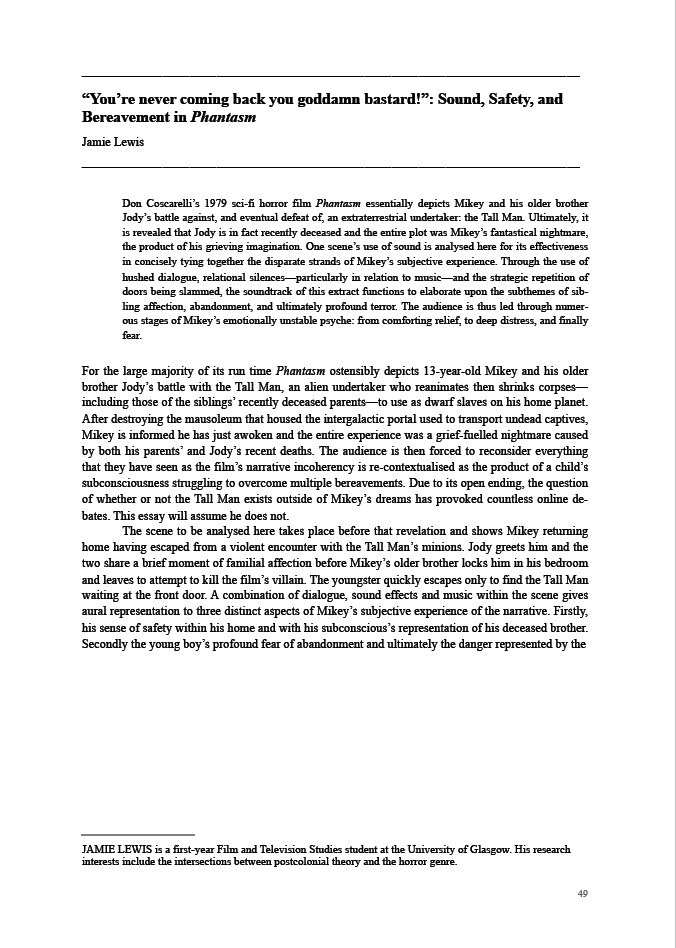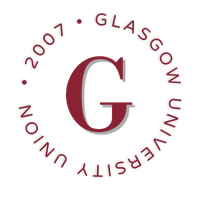“You’re never coming back you goddamn bastard!”
Sound, Safety, and Bereavement in Phantasm
DOI:
https://doi.org/10.36399/GroundingsUG.11.176Keywords:
Phantasm, Scene Study, Sound, Safety, Bereavement, Don CoscarelliAbstract
Don Coscarelli’s 1979 sci-fi horror film Phantasm essentially depicts Mikey and his older brother Jody’s battle against, and eventual defeat of, an extraterrestrial undertaker: the Tall Man. Ultimately, it is revealed that Jody is in fact recently deceased and the entire plot was Mikey’s fantastical nightmare, the product of his grieving imagination. One scene’s use of sound is analysed here for its effectiveness in concisely tying together the disparate strands of Mikey’s subjective experience. Through the use of hushed dialogue, relational silences—particularly in relation to music—and the strategic repetition of doors being slammed, the soundtrack of this extract functions to elaborate upon the subthemes of sibling affection, abandonment, and ultimately profound terror. The audience is thus led through numerous stages of Mikey’s emotionally unstable psyche: from comforting relief, to deep distress, and finally fear.
References
Coscarelli, Don. Phantasm. Los Angeles: AVCO Embassy Pictures, 1979.
Dyer, Richard. Se7en. London: bfi Publishing, 1999.
Hegarty, Paul. Noise/Music: A History. London: Bloomsbury Continuum, 2007.
Lury, Karen. “CSI and Sound.” In Reading CSI: Crime TV Under the Microscope, edited by Michael Allen, 107–121. New York: IB Tauris & Co Ltd, 2007.
Macan, Edward. Rocking the Classics: English Progressive Rock and the Counterculture. Oxford: Oxford University Press, 1997.
Moore, A.F. Song Means: Analysing and Interpreting Recorded Popular Song. London: Routledge, 2016.
Thebérge, P. “Almost Silent: The Interplay of Sound and Silence in Contemporary Cinema and Tele-vision.” In T. G. Jay Beck, Lowering the Boom: Critical Studies in Film Sound, 51–67. Urbana, Illinois: University of Illinois Press, 2008.

Downloads
Published
Issue
Section
License
Copyright (c) 2018 Jamie Lewis

This work is licensed under a Creative Commons Attribution 4.0 International License.
The CC BY 4.0 license is a Creative Commons license. This is a non-copyleft free license that is good for art and entertainment works, and educational works. It is compatible with all versions of the GNU GPL; however, like all CC licenses, it should not be used on software. People are free to: Share — copy and redistribute the material in any medium or format; Adapt — remix, transform, and build upon the material for any purpose, even commercially. The licensor cannot revoke these freedoms as long as you follow the license terms. But they must conform to the following terms: Attribution — You must give appropriate credit, provide a link to the license, and indicate if changes were made. You may do so in any reasonable manner, but not in any way that suggests the licensor endorses you or your use. No additional restrictions — You may not apply legal terms or technological measures that legally restrict others from doing anything the license permits.
Please check individual article PDF copies to see if any additional restrictions apply.







